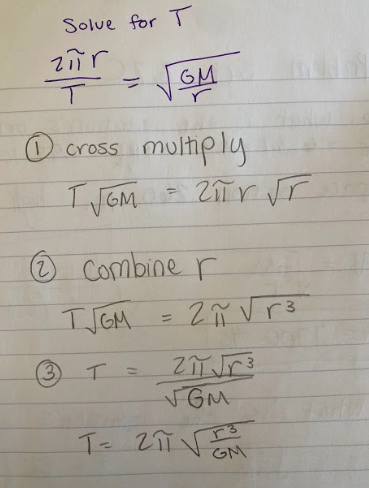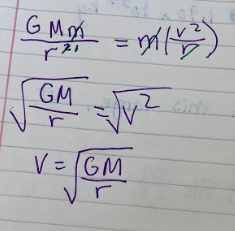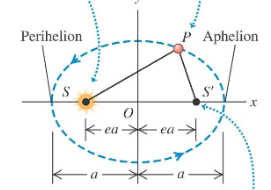Unit 3 - Uniform Circular Motion, gravitational force, and orbits
0.0(0)
0.0(0)
Card Sorting
1/25
Earn XP
Description and Tags
Study Analytics
Name | Mastery | Learn | Test | Matching | Spaced |
|---|
No study sessions yet.
26 Terms
1
New cards
period
time it takes an object to complete one revolution (secs/revolution)
2
New cards
frequency
number of revolutions an object completes in one second (revolutions/sec or sec^-1)
3
New cards
T =
1/f
4
New cards
f =
1/T
5
New cards
centripetal acceleration
v^2/r
6
New cards
Fnet =
m(v^2/r)
7
New cards
Newton's Law of Universal Gravitation
gravitational force is a force that acts between any two objects with mass
8
New cards
gravitational force
G(m1xm2)/r^2
9
New cards
gravitational field strength
Gmplanet/r^2
10
New cards
Derive T from universal gravitation equation
1. cross multiply
2. combine r
3. solve for T
2. combine r
3. solve for T

11
New cards
Derive orbit velocity
1. get rid of m and 1 r
2. square root both sides
2. square root both sides

12
New cards
Kepler's 1st and 2nd law
-orbits are not perfect circles they are ellipses
-they sweep out equal areas in equal times
-this is why the object orbit travels faster when it is closer to the center
-they sweep out equal areas in equal times
-this is why the object orbit travels faster when it is closer to the center
13
New cards
Kepler's 3rd law
T has a direct relationship with r^3/2
14
New cards
About 2.8 times as long
- bc increasing the semimajor axis by a factor of two will cause an increase of the square root of 2 raised to the 3rd power of the period.
- bc increasing the semimajor axis by a factor of two will cause an increase of the square root of 2 raised to the 3rd power of the period.
According to Kepler’s third law of planetary motion, if the Earth’s orbit was twice as large as it is, how long would it take for the Earth to go around the Sun once?
15
New cards
The Sun is at one focus of the ellipse, with nothing at the other focus.
Kepler’s first law of planetary motion tells us that planets move in ellipses. If we picture the elliptical orbit of a planet orbiting the Sun, where does the Sun fit into the picture?

16
New cards
The orbit is shaped like an ellipse.
If a planet is orbiting a star, what is the most accurate way to describe the shape of the orbit?
17
New cards
it moves with a higher speed during some parts of its orbit and a slower speed during other parts.
In general, when a planet orbits a star, ______.
18
New cards
The empty toolbox has a much smaller mass, so it is much easier to move it around.
explanation - Both toolboxes have the same mass as they would anywhere else (such as on the Earth’s surface), which means they both respond to forces in the way they would anywhere else: The empty toolbox will accelerate rapidly due to its small mass, while the full toolbox will be difficult to accelerate.
explanation - Both toolboxes have the same mass as they would anywhere else (such as on the Earth’s surface), which means they both respond to forces in the way they would anywhere else: The empty toolbox will accelerate rapidly due to its small mass, while the full toolbox will be difficult to accelerate.
Suppose you are floating in deep space (in a space suit). You grab onto two identical toolboxes, one of which is full of metal tools and the other of which is empty. As you shake the two tool boxes around by their handles, which is the correct statement about what you would notice?
19
New cards
Yes, this is about the rock’s mass, which is the same on the Moon as on the Earth.
explanation - The reason you might break your toe is that the rock doesn’t get out of the way, creating a very large force between your toe and the rock. The reason the rock doesn’t get out of the way is that it has a very large mass and doesn’t accelerate quickly in response to the force from your foot.
explanation - The reason you might break your toe is that the rock doesn’t get out of the way, creating a very large force between your toe and the rock. The reason the rock doesn’t get out of the way is that it has a very large mass and doesn’t accelerate quickly in response to the force from your foot.
If you kick a big rock very hard while on the Earth, you might break a toe. If you kicked a similar rock while on the Moon, would you still be in danger of breaking your toe?
20
New cards
A planet’s orbital period and the size of the planet’s orbit are related.
Kepler’s third law of planetary motion states that which two quantities are related?
21
New cards
This is not possible, since it would violate Kepler’s third law of planetary motion.
Exoplanets (planets outside our solar system) are an active area of modern research. Suppose you read an article stating that there is a newly discovered planetary system with three planets. The article states that the outermost planet (Planet C) goes all the way around its star in less time than the innermost planet (Planet A). According to Kepler’s laws of planetary motion, is this possible?
22
New cards
Roughly 12 m/s2
explanation - After the mass of the object is canceled from both sides of the equation, we see that the acceleration due to gravity is proportional to the inverse-square of the planet’s radius. Thus, if the radius of the planet is 10% less than Earth’s but has the same mass, we would expect the acceleration due to gravity to be increased by a factor of start fraction 1/0.9^2 or about 1.2, raising it to 12 m/s2.
explanation - After the mass of the object is canceled from both sides of the equation, we see that the acceleration due to gravity is proportional to the inverse-square of the planet’s radius. Thus, if the radius of the planet is 10% less than Earth’s but has the same mass, we would expect the acceleration due to gravity to be increased by a factor of start fraction 1/0.9^2 or about 1.2, raising it to 12 m/s2.
Exoplanets (planets outside our solar system) are an active area of modern research. Suppose astronomers find such a planet that has the same mass as Earth, but has a radius that is about 10% less. Roughly, what acceleration due to gravity would you expect if you were standing on the surface of this new planet?

23
New cards
No, orbiting every 24 hours only happens at one specific orbital distance.
explanation - We can see that the mass of the satellite will cancel out. In addition, the result is a strict relationship between the speed of the orbit and the size of the orbit.
explanation - We can see that the mass of the satellite will cancel out. In addition, the result is a strict relationship between the speed of the orbit and the size of the orbit.
A communications company requests that their satellite be placed 100,000 meters above the Earth's surface and then launched so that it moves in a geosynchronous orbit (meaning an orbit that takes exactly 24 hours to complete). Is this possible?
24
New cards
The Earth is big enough and close enough to cause a noticeable effect.
explanation - The force of gravity between two objects gets weaker rapidly as the two objects get further apart. In addition, it takes a relatively large amount of mass for gravitational effects to become noticeable in comparison to the other day-to-day forces on a person. The mass and proximity of the Earth mean that its force is the only one substantial enough for us to notice.
explanation - The force of gravity between two objects gets weaker rapidly as the two objects get further apart. In addition, it takes a relatively large amount of mass for gravitational effects to become noticeable in comparison to the other day-to-day forces on a person. The mass and proximity of the Earth mean that its force is the only one substantial enough for us to notice.
If every object is attracted to every other object in the universe via gravity, why is it that you feel only one force of gravity on a day-to-day basis (the one from Earth)?
25
New cards
Roughly 9 m/s^2
explanation - After the mass of the object is canceled from both sides of the equation, we see that the acceleration due to gravity is directly proportional to the mass of the planet. Thus, if the mass of the planet is 10% less than Earth’s but has the same radius, we would expect the acceleration due to gravity to be reduced by 10%, down to about 9 m/s2.
explanation - After the mass of the object is canceled from both sides of the equation, we see that the acceleration due to gravity is directly proportional to the mass of the planet. Thus, if the mass of the planet is 10% less than Earth’s but has the same radius, we would expect the acceleration due to gravity to be reduced by 10%, down to about 9 m/s2.
Exoplanets (planets outside our solar system) are an active area of modern research. Suppose astronomers find such a planet that has the same radius as Earth, but is about 10% less massive. Roughly, what acceleration due to gravity would you expect if you were standing on the surface of this new planet?
26
New cards
Mass and weight have different units.
Which of the following is an important difference between an object’s mass and its weight?